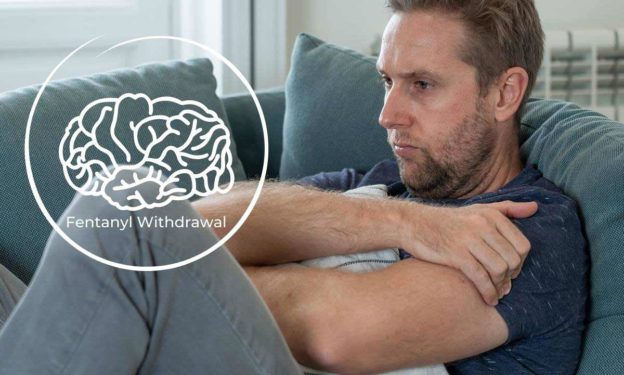Fentanyl is a powerful opioid drug available in transdermal patches (Duragesic), as a lozenge (Aqtic), or as an injectable (Sublimaze). Although this medication has a similar mechanism of action to heroin, it is much more potent. NIDA reports it to be 50 to 100 times more powerful than morphine, making fentanyl withdrawal incredibly challenging to surpass.
Fentanyl Addiction
The Drug Enforcement Administration (DEA) reports a massive rise in abuse and overdose deaths related to fentanyl in the last year. A crisis of epidemic proportions, responsible for taking people’s lives and destroying families at unspeakable rates.
There are many reasons why people become addicted to fentanyl; some of the most common are:
- To mask untreated mental health issues.
- Over-prescribing of opioids for pain management.
- The wide availability of the drug due to the influx of drug smuggling through our borders.
- Lack of substance abuse knowledge and education.
- Self-medicating emotional distress.
Opioid Dependence
When someone takes an opioid drug for a certain amount of time, changes in brain chemistry occur. A powerful drug like fentanyl can quickly lead to severe physical dependence when used regularly. Opioids affect the central nervous system (CNS), leading to modifications to how neurotransmitters function and physical dependence. Once a person becomes dependent and discontinues using the drug, opioid withdrawal syndrome begins.
For over 26 years, people from all over the world have chosen Waismann Method as their opioid detox provider.
We know the challenges you face and the importance of creating a unique and personal experience for you right from the start.Call for Detox Options 1-800-423-2482
Fentanyl Withdrawal Timeline and Symptoms
A fentanyl withdrawal is a sign of the brain struggling to restore balance after the drug is no longer present. For example. these symptoms may feel like a combination of the terrible flu and extreme anxiety. Fentanyl dependence can occur regardless of whether a person is taking the drug for medical reasons or recreationally. The idea of bearing the agony of withdrawal can be overwhelming, making many people remain in the endless circle of addiction.
How long does fentanyl withdrawal last?
Fentanyl withdrawal syndrome usually begins within 6-30 hours of the last dose. The patch form is an extended-release, and the effects may continue to progress for the first 12-24 hours of removing it, lasting up to 5 to 7 days — withdrawal syndrome often peaks in the first few days and levels off within a week. However, Medically assisted detox and rapid detoxification can significantly reduce the length and discomfort of these symptoms.
The most common fentanyl withdrawal symptoms are:
- Sweating
- Restlessness
- Runny nose
- Chills
- Severe stomach cramps
- Pain in joints and/or muscles
- Muscle pain
- Nausea and/or vomiting
- Diarrhea
- Elevated heart rate
- Hypertension
- Increased respiratory rate
- Anxiety
- Insomnia
- Pupil dilation
When detoxing from fentanyl, emotional symptoms such as depression and anxiety directly result from the disruption in dopamine levels. Also, drug cravings may be intense and persist even after detoxification. More importantly, when detoxification is achieved, non-addictive medications such as Vivitrol and Naltrexone are great tools for controlling physical cravings.
Call one of our admissions specialists today. Let us help you better the quality of your life and get the help you need today!
It is not recommended to detox cold turkey, or without professional supervision. At the Waismann Method® Opioid Detox Specialists, we offer rapid detox, medically assisted detox, and individualized guidance in addiction treatment.Call 1-800-423-2482
Medically Assisted Withdrawal Treatment
Detoxing from opioids may not feel the same for everyone. Therefore, several factors may require modification of the detox protocol, including:
- Dependence level
- Co-occurring health disorders
- Severity of addiction
- Length of time-dependent on opioids
- Abuse of other substances
It is critical for patients’ safety and success that a medical professional helps people plan a specific detox program. Ultimately, a doctor can help patients come off fentanyl safely while minimizing the health risks and discomfort of withdrawal symptoms.
Don’t let fear stop you. There is a humane and comfortable way out. You are suffering from a medical condition, and you deserve to get the medical help you need to recover.
Fentanyl Detox Treatment Options
Medically Assisted Opioid Detox
Medically assisted opioid detox can happen in a hospital or a residential program, depending on the individual’s specific health needs. Typically, a hospital detox includes around-the-clock monitoring of a medical team to manage vital and withdrawal symptoms. In some cases, patients choose to undergo detoxification under anesthesia (rapid detox).
Anesthesia helps the patient overcome the worst of a withdrawal syndrome while they sleep under sedation. The other benefit of anesthesia detox is that Vivitrol or Naltrexone therapy can start immediately and with no delays, dramatically reducing cravings and chances of relapse.
Residential Detox
A residential detox includes a team of clinicians that provides medical and mental health support around the clock. Throughout the program, supportive medications are also used to manage physical and emotional withdrawal symptoms. A residential detox is usually recommended for young health or low-dose patients. The detoxification phase typically lasts about 5-7 days, with some remaining symptoms lingering a little longer. At Domus Retreat, a detox program often requires an 8 to 14-day commitment with available extensions if more days are necessary. Some people may require more or less inpatient assistance, as drug detox is unique for each individual.
Medication-Assisted Treatment (MAT)
In some treatment programs, fentanyl is replaced with a different opioid agonist during detox to aid or prevent opioid withdrawal. The most common Medication-Assisted Treatment (MAT) includes buprenorphine. Buprenorphine is an FDA-approved partial opioid agonist used to treat opioid dependence. It is available by the brand names Bunavail, Sublocade, Suboxone, Subutex, and Zubsolv. These MAT drugs attach to the receptor sites like other opioids, reducing withdrawal symptoms without producing the desired euphoric “high.” Although buprenorphine-based medications can help people achieve a safer state and prevent overdose, it’s still an opioid with addictive properties that causes withdrawal.
Conclusion
If you have not been able to withdraw from fentanyl, you should consider seeking the assistance of a medical professional. Medical detox can be highly beneficial in helping someone safely and effectively get through opioid detoxification. A comprehensive fentanyl detoxification includes aftercare consisting of anti-craving non-opioid medications, emotional assessment, and an individualized treatment plan. Therefore, the possibilities of long-term success are significantly higher.
Although fentanyl addiction is a challenging and powerful condition, it can be successfully defeated. It is also a condition that cannot be ignored or dismissed because it can easily lead to fatal consequences. Find a treatment center committed to your recovery— a program with a solid foundation, experienced board-certified professionals, and a reputation for excellence. Waismann Method® and Domus Retreat have joined forces to provide patients the most advanced protocols for medical opioid detoxification with the compassion, care and respect you deserve.
Waismann Method® is an industry leader in rapid detox and medical detoxification for those suffering from fentanyl addiction. Our team of top medical experts and specialists is committed to ensuring that each patient is treated with professionalism, safety, and compassion.
Sources:
- National Institute on Drug Abuse: Fentanyl
- Drug Enforcement Administration: Fentanyl
- Substance Abuse and Mental Health Services Administration: Medication Assisted Treatment (MAT)
- FDA: Is It Really ‘FDA Approved?’
- SUBLOCADE® (Buprenorphine Extended-release) Injection
Reviewed by Clare Waismann, Registered Addiction Specialist (RAS), Substance Use Disorder Certified Counselor (SUDCC), founder of Waismann Method® Advanced Treatment for Opiate Dependence and Domus Retreat®. Clare Waismann is an authority and expert on opioid dependence, opioid use disorder, substance dependence, detoxification treatments, detox recovery, and other topics covered on RapidDetox.com.







